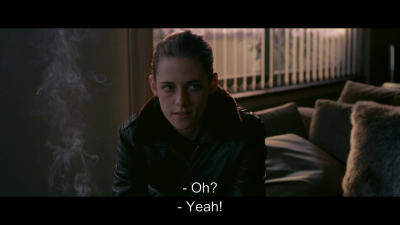By: Ted Nannicelli, University of Queensland
In the context of scholarship on the arts, the term “contingent universals” derives from a 1996 essay by the preeminent film historian and theorist, David Bordwell. [1] The essay, entitled “Convention, Construction, and Cinematic Vision,” was reprinted in an expanded form in 2008, and it is this version I shall reference in the present entry.
First, some context: In his essay, Bordwell investigates a specific research question as part of his exploration of a broader issue. The broad topic has to do with the nature and function of artistic conventions in cinema. The specific research question Bordwell tries to answer in order to make headway on the broader issue is: “What makes the shot/reverse-shot comprehensible?” (58). Shot/ reverse-shot, as Bordwell explains, is a film editing technique that alternates shots of two characters conversing. Sometimes individual shots will show just one of the two characters (a “single” [see Figure 1]), and sometimes they will feature one character in the frame with a small part of the other character’s body slightly visible in the foreground as if the camera is shooting from behind it (an “over-the-shoulder” [see Figure 2]).


Figure 1. A standard shot/ reverse-shot from Personal Shopper (2016).


Figure 2. An over-the-shoulder shot/reverse-shot from Raw (2016).
Bordwell argues it is plausible that the shot/reverse-shot is a specifically cinematic technique. It was invented in American cinema during the 1910s, spread worldwide soon thereafter, and is now one of the most commonly used techniques in all of cinema (and other moving image media like television). The wide cross-cultural adoption of shot/reverse-shot demands an explanation: Just how is it that the technique is comprehensible across cultures and cinematic traditions? The challenge, Bordwell convincingly argues, is to develop an account that moves beyond the naturalist/conventionalist binary opposition, according to which the technique’s widespread comprehensibility is either wholly a matter of “nature” or is a purely arbitrary “convention.” According to Bordwell, the nature/culture opposition overlooks the plausible idea that “many aspects of film style [including shot/reverse-shot] are transformations of a variety of cross-cultural skills and practices, both biological and cultural” (76, emphasis in original).
This is where the notion of “contingent universals” comes into play. Bordwell’s contention is that particular cinematic techniques like shot/reverse-shot have developed and spread cross-culturally because they “amplify and streamline” certain “contingent universal” human practices “for easy uptake” (76). On this account, “contingent universals” just are human skills, practices, and the like that are near (if not absolute) universals “insofar as we can find them to be widely present in human societies,” yet “did not, for any metaphysical reasons, have to be the way they are” (Bordwell 61). In the case of the shot/reverse-shot technique, the relevant underlying contingent universals are plausibly face-to-face interaction and conversational turn-taking because these provide a compelling explanation of “why the situation portrayed in shot/reverse-shot is instantly recognizable across cultures and time periods” (Bordwell 64). More broadly, Bordwell argues, “Neither wholly ‘natural’ nor wholly ‘cultural,’ these sorts of contingent universals are good candidates for being at least partly responsible for the ‘naturalness’ of artistic conventions” (61).
Like a number of other leading scholars who have studied and described human universals (e.g. Brown), Bordwell emphasizes that merely asserting the existence of contingent universals does not commit him to a particular account of how or why they exist (62; 76). That is, pace his critics (e.g. Hansen), Bordwell is not claiming that contingent universals are necessarily or essentially products of human nature alone. His more modest view is that they likely arise from the interaction of biological and environmental (broadly construed to include cultural) factors. That said, different contingent universals are likely to depend upon different combinations of nature and environment, such that at least some will owe more to human biological traits and some will owe more to the way certain practices develop within specific environments.
This point leads to the broader question of whether there are any contingent universals in cinema or other art forms, or whether contingent universals are better thought of as merely underpinning, to a greater or lesser extent, certain widespread, cross-culturally intelligible conventions whose realization is nevertheless variable. Although Bordwell doesn’t put things quite in these terms, it would seem that especially good candidates for contingent universals in cinema are indeed techniques or features that are underpinned by factors on the biological end of the spectrum. What he does say is that “among the best candidates we have for wired-in responses” are “sensory triggers [which] are cues that automatically stimulate spectators” (Bordwell 63). In the context of cinema, Bordwell notes, an obvious sensory trigger and plausible contingent universal is apparent motion. That is, our engagement with cinema in any tradition necessarily depends upon our biologically innate ability to perceive motion in certain contexts (like cinema) where in fact there is none. So, apparent motion is at least one plausible example of a contingent universal that underpins our experience of cinema and is a contingent universal in cinema.
One might worry that this is an uninformative claim: Of course, whatever specific characteristics of our biological endowment are necessary to our engagement with a particular art form will underpin a number of contingent universal features of that art form – namely, whatever features depend upon our biological endowment in order to be perceived, cognized, and so forth. But while the claim may seem obvious to some, it is far from uncontroversial. For in some cases, it is precisely those features that depend upon our biological endowment that are contested. According to some traditions in visual culture, art theory, film and media studies, for example, pictures represent content in a way that has little, if anything to do with our natural perceptual capacities because pictorial representation is entirely conventional (e.g. Heath; Nichols; Mitchell). On such views, features of pictures that might strike some theorists as contingent universals – say, the use of lighting to create contour – could well strike others as the “arbitrary” conventions of a particular tradition (Mitchell 86). In other words, anyone who is sceptical that biological factors have any role to play in our engagement with art is likely to be sceptical of some of the best candidates for contingent universals in those arts.
Here is one reason for standing fast against the strong conventionalist position (beyond its intrinsic difficulties [2]) and emphasising the biological grounding of some contingent universals, at least in the context of cinema. Cinema is a “sensual medium” (Plantinga 112). The basis of the sensory triggers Bordwell identifies is the fact that cinema directly engages a number of our sense modalities in ways that are unavailable to an art form like literature (see, e.g., Carroll; Coplan and Matravers 118-126). For this reason, it seems plausible that, if there are indeed contingent universals in cinema, which elicit congruent physical responses across culturally diverse audiences– for example, the “jump scare,” caused by the startle response – they would probably be biologically grounded. According to prominent neuroscientist Joseph LeDoux, such precognitive “affective appraisals” occur via a “quick and dirty processing system” (163). It seems likely that those emotions fundamental to our survival — fear, disgust, anger, surprise, happiness and sadness – are grounded in such automatic “affective appraisals,” which bypass higher-order cognitive processing and, thus, the influence of culture, broadly speaking. This suggests that, in fact, a number of familiar, cinematically elicited emotions might be biologically grounded contingent universals (also see Plantinga and Smith; Smith).
Notwithstanding what has been said so far, it is worth pointing out one reason why the study of contingent universals in relatively newer art forms like cinema may prove particularly challenging. Unlike literature, cinema does not have a range of traditions that are “genetically and areally” (Hogan 17) distinct. That is, thanks to the nature of cinematic technology and its rapid global spread in the 20th century, it seems unlikely that there are any cinematic traditions that have not been mutually influenced to some extent, and thus difficult to identify a feature that has appeared spontaneously across genetically and areally distinct traditions. This is not to downplay the existence or importance of narrative and stylistic commonalities across different cinematic traditions; it is just to acknowledge that such commonalities may not meet the sort of formal criteria Hogan discusses for counting as universals properly so-called. That said, Bordwell’s shot/reverse-shot case study shows that the identification of contingent universals that underwrite widespread (if not technically universal) cinematic techniques is informative in its own right. So, too, we might note that the notion of a contingent universal may prove useful in understanding commonalities of a broader sort – namely, across art and the domain of the aesthetic more generally (see, e.g., Davies; Dutton).
Future Research
Needless to say, there is significant scope for further study of contingent universals. To some extent, this research has been proceeding apace under the guise of different terms such as “cultural universals,” “near universals,” and so forth (see Antweiler 40-45 on differing terminology). One of the merits of the term “contingent universals,” however, is that it signals to potential skeptics its status as a moderate position between nativist and culturalist extremes. At the same time, developing our understanding of how contingent universals underpin and operate within the arts may require scholars to specify a narrower category or class for the purpose of answering particular research questions. In philosophical aesthetics, a live research question is whether there are contingent aesthetic universals. But literary or film theorists are likely to pursue rather narrower research questions, which might involve focusing on a putative class of, say, contingent universals of emotion, contingent universals of language, contingent universals of visual perception, and so forth.
[See also Patrick Colm Hogan, “Comments on Nannicelli.”]
Works Cited
Antweiler, Christoph. Our Common Denominator: Human Universals Revisited. Translated by Diane Kerns. New York: Berghahn, 2016.
Bordwell, David. “Convention, Construction, and Cinematic Vision.” In Poetics of Cinema, 57-82. New York: Routledge, 2008.
Brown, Donald E. Human Universals. Philadelphia, PA: Temple University Press, 1991.
Buller, David. Adapting Minds: Evolutionary Psychology and the Persistent Quest for Human Nature. Cambridge, MA: The MIT Press, 2005.
Carroll, Noël. “The Power of Movies.” In Theorizing the Moving Image, 78-93. Cambridge: Cambridge University Press, 1996.
Coplan, Amy, and Derek Matravers. “Film, Literature, and Non-Cognitive Affect.” In New Takes in Film-Philosophy, 117-134. Edited by Havi Carel and Greg Tuck. Basingstoke: Palgrave Macmillan, 2011.
Davies, Stephen. The Artful Species. Oxford: Oxford University Press, 2012.
Dutton, Dennis. The Art Instinct: Beauty, Pleasure, and Human Evolution. New York: Bloomsbury, 2009.
Hansen, Miriam Bratu. “The Mass Production of the Senses: Classical Cinema as Vernacular Modernism.” In Reinventing Film Studies, 332-350. Edited by Christine Gledhill and Linda Williams. London: Arnold, 2000.
Heath, Stephen. Questions of Cinema. Bloomington, IN: Indiana University Press, 1981.
Hogan, Patrick Colm. The Mind and its Stories: Narrative Universals and Human Emotion. Cambridge: Cambridge University Press, 2003.
LeDoux, Joseph. The Emotional Brain: The Mysterious Underpinnings of Emotional Life. New York: Simon & Schuster, 1996.
Mellor, D.H. “Properties and Predicates.” In Ontology, Causality, and Mind: Essays in Honor of D.M. Armstrong, 101-120. Edited by John Bacon, Keith Campbell, and Lloyd Reinhardt. Cambridge: Cambridge University Press, 1993.
Mitchell, W.J.T. Iconology: Image, Text, Ideology. Chicago: University of Chicago Press, 1986.
Nichols, Bill. Ideology and the Image. Bloomington, IN: Indiana University Press, 1981.
Plantinga, Carl. Moving Viewers: American Film and the Spectator’s Experience. Berkeley, CA: University of California Press, 2009.
Plantinga, Carl, and Greg M. Smith. Passionate Views: Film, Cognition, and Emotion. Baltimore, MD: Johns Hopkins University Press, 1999.
Smith, Murray. Film, Art, and the Third Culture: A Naturalized Aesthetics of Film. Oxford: Oxford University Press, 2017
Notes
[1] As Bordwell notes, there is a helpful, broader discussion of a similar concept – “cultural universals” – in Buller, especially 462-471. It should be noted that there is also a philosophical sense in which the term “contingent universals” is sometimes used (e.g. Mellor). As I discuss below, Bordwell makes clear that his use of the term is not to be understood in this sense, which involves metaphysical claims.
[2] For a good introductory discussion of these difficulties, as well as number of references to key positions in the literature, see David Bordwell, “You and Me and Every Frog We Know,” Observations on Film Art blog (September 20, 2015; accessed August 9, 2017).